VFA-115
| Strike Fighter Squadron 115 | |
|---|---|
|
VFA-115 insignia | |
| Active | 10 October 1942 - present |
| Country | United States of America |
| Branch |
|
| Type | Fighter/Attack |
| Role |
Close air support Air interdiction Aerial reconnaissance |
| Part of | Carrier Air Wing 5 |
| Garrison/HQ | Naval Air Facility Atsugi |
| Nickname(s) |
Little Butch Eagles Arabs |
| Engagements |
World War II Korean War Vietnam War Operation Southern Watch Operation Desert Fox Operation Enduring Freedom Iraq War |
| Aircraft flown | |
| Attack |
TBF Avenger AD/A-1 Skyraider A-6 Intruder |
| Fighter |
F/A-18 Hornet F/A-18F Super Hornet |
Strike Fighter Squadron 115 (VFA-115) is known as the "Eagles", callsign "Talon", a United States Navy F/A-18E Super Hornet strike fighter squadron stationed at Naval Air Facility Atsugi. Their tail code is NF.
Squadron Insignia and Nickname

The squadron’s first insignia was designed by Walt Disney and consisted of a black torpedo with the skull & crossbones on it and a winged cherub wearing a green helmet nicknamed "Little Butch." A new squadron insignia was approved on 17 September 1956 and is still in use. The squadron was known as the "Arabs" from the 1950s to 1979, at which time they were renamed the "Eagles". During the squadron’s deployment to the Indian Ocean in 1989, they temporarily changed their nickname back to Arabs to enhance the morale while operating in the Arabian Sea.
History
1940s
Torpedo Squadron Eleven (VT-11) was established at Naval Air Station San Diego on 10 October 1942, flying TBF Avengers. Over the next five years, the squadron upgraded through several models of TBF and TBM Avengers.
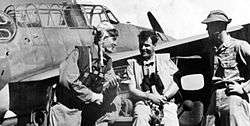
On 25 April 1943, VT-11 arrived at Guadalcanal. The squadron's first combat was flown from Henderson Field as part of Carrier Air Group Eleven (CVG-11). The squadron was land-based at Guadalcanal, and in June 1943, VT-11 pilots conducted the first daylight raids on Bougainville and the Solomon Islands. They flew patrol, search, spotting, strike, and night mine-laying missions.
From 29 September 1944 to 1 February 1945, VT-11 was deployed aboard the USS Hornet. The squadron participated in the first strikes against Okinawa and two weeks later converged on Leyte Gulf to protect the landing and supply ships engaged in the Battle of Leyte. On October 25, the Japanese Fleet converged on Leyte to oppose the landings. Squadron TBMs were launched from 550 km (340 mi) away (well beyond normal range) to strike the fleet. The TBMs struck the retiring Japanese ships, scoring hits on a battleship and two cruisers. All the squadron’s aircraft returned, completing a 1.000 km (600 mi) round trip. Seven Navy Crosses were awarded to VT-11 aircrews during this campaign.
In November and December 1944, the squadron continued to provide support for the occupation of Leyte, striking targets on Luzon in support of the landings on Mindoro. In January 1945, the squadron struck ships and targets on Formosa and Luzon in support of the Invasion of Lingayen Gulf, Luzon. The squadron participated in operations in the South China Sea (the first time an American Task Force had entered these waters since the beginning of the war), striking targets at Cam Ranh Bay and a convoy off Qui Nhơn, French Indo-China, shipping at the Pescadores Island, and Hong Kong.
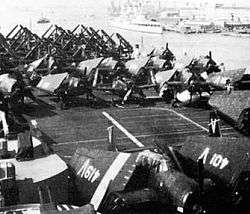
An exhibit honoring VT-11 during World War II is on board the USS Hornet Museum in Alameda, California.
After the war, Naval Air Station San Diego became VT-11's new homeport, and the squadron was redesignated as Attack Squadron 12A (VA-12A) in November 1946. VA-12A, along with Carrier Air Group (CVAG-11), underwent extensive training and embarked on USS Valley Forge, the U.S. Navy's newest aircraft carrier. In June 1948, VA-12A deployed on a world cruise, a first for a U.S. Navy air group and milestone for the squadron. A symbolic globe later became part of the squadron's official insignia to commemorate the cruise.
On July 15, 1948, VA-12A was re-designated Attack Squadron 115 (VA-115), and in December, the squadron transitioned to the AD Skyraider, operating several improved models over the next ten years.
1950s
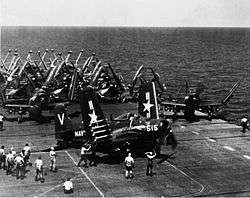
In July 1950, VA-115 deployed aboard USS Philippine Sea for nine months conducting strikes at Inchon, South Korea in preparation for landings in September 1950. During and after the invasion the squadron flew deep support missions and also encountered MiG-15s. On 31 December 1951, VA-115 provided close air support for American troops in the Chosen Reservoir area and flew combat missions against North Korean rail, transportation, communication, industrial and supply targets. VA-115 flew 2,268 combat missions over both Korea deployments. For this outstanding performance, the squadron was awarded the Presidential Unit Citation.
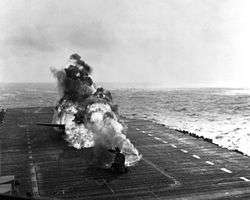
In June 1952, the squadron participated in coordinated strikes against North Korean hydroelectric power plants - the first heavy attacks conducted against these installations. Nine different hydroelectric power plants were struck. VA-115 made two deployments to Korea in 1950/51 and 1951/52 aboard the USS Philippine Sea. It returned to Korea shortly after the Armistice Agreement in July 1953 aboard the USS Kearsarge. This was followed by another deployment on the USS Kearsarge in 1954/55.
In February 1955, the squadron flew air cover missions during the evacuation of over 26,000 personnel from Tachen Islands which had come under bombardment by the People’s Republic of China (PRC) in January. In August and September 1958, the squadron was part of the task force that provided support to the Republic of China during the shelling of the Quemoy Island group by the PRC.
CVG-11 then moved to the USS Essex in 1956, followed by two cruises aboard the USS Shangri-La in 1958 and 1959.
1960s
In 1960 the squadron adopted the nickname "Arabs" after passage through the Suez Canal, while being deployed aboard the USS Hancock in 1960/61.
Later in 1961 CVW-11 was reassigned to the USS Kitty Hawk. VA-115 made three deployments aboard the Kitty Hawk to the Western Pacific between 1962 and 1966. In May and June 1964, during the Laotian crisis, the squadron flew Combat Air Patrol and Search and Rescue.
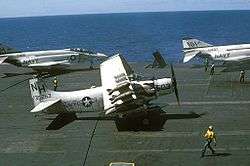
In October 1965, the squadron returned to Southeast Asia. During six months on Yankee Station in the Gulf of Tonkin, VA-115 flew 2,051 sorties, over 8,000 hours and delivered 3,200 t (7 mio lb) of ordnance against enemy targets in Vietnam. In September 1966, VA-115 joined Carrier Air Wing Five aboard the USS Hancock and made its second deployment to Vietnam from January to July 1967.
From August 1967 to January 1970, the squadron was put in an inactive, stand-down status. This was a transitional period as the squadron awaited the arrival of the A-6 Intruder, and there were no aircraft and only a few administrative personnel assigned. This is the only known instance in which a squadron was not disestablished but remained on the active squadron inventory in an inactive status.
1970s
In January 1970, the squadron resumed active status and was reassigned to Naval Air Station Whidbey Island, Washington for transition to the A-6 Intruder. The squadron received their first KA-6D tanker aircraft in February 1971. In 1970 VA-115 was assigned to Carrier Air Wing 16 (CVW-16) (tail code "AH") for deployment on the modernized USS Midway. However, the modernization of Midway took longer than expected, CVW-16 was disestablished in 1971 and all its squadrons were assigned to Carrier Air Wing Five (CVW-5) (tail code "NF"). From 1971 to 1990 VA-115 and CVW-5 were assigned to the USS Midway. In 1971 and 1972/73 USS Midway made two deployeents to Vietnam. From May to October 1972 VA-115 participated in Operation Linebacker, where VA-115 earned a fourth Presidential Unit Citation.
In September 1973, USS Midway changed homeport to Yokosuka, Japan, and CVW-5 was based at NAF Atsugi. USS Midway and VA-115 would again serve off the coast of Vietnam and in 1975, participated in Operation Eagle Pull, the evacuation of Phnom Penh and Operation Frequent Wind, the evacuation of Saigon.
In August and September 1976 USS Midway and VA-115 operated off Korea following the Axe murder incident. In early 1977, VA-115 transitioned to the A-6E. The squadron then became the "Eagles," officially changing the nickname in March 1978.
From April to May 1979 the USS Midway, with VA-115 embarked, deployed to the Gulf of Aden to relieve the USS Constellation and maintain a U.S. carrier presence following the outbreak of fighting between North Yemen and South Yemen and the Iranian Revolution. As a response to anti-American demonstrations in Iran, Midway and her air wing, including VA-115, were ordered to deploy to the Indian Ocean for the second time from October to December 1979, when an Iranian mob also seized the American Embassy and its staff.
1980s
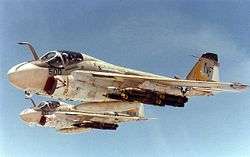
In May and June 1980 following the Gwangju Uprising in South Korea, the squadron operated from Midway off the coast of South Korea until the crisis subsided. USS Midway operated again off South Korea in December 1981 following political unrest. During the 1988 Summer Olympics, in Seoul, South Korea, the squadron was embarked on Midway operating in the Sea of Japan to demonstrate U.S. support for a peaceful Olympics.
1990s
The squadron deployed again to the Middle East in support of Operation Earnest Will, the escort of re-flagged Kuwaiti tankers in the Persian Gulf. In October 1990, the squadron deployed to the North Persian Gulf in support of Operation Desert Shield. On 17 January 1991, squadron Intruders launched from the deck of USS Midway against Iraqi targets to mark the beginning of Operation Desert Storm. In total, the squadron flew 456 combat sorties and delivered 724,000 pounds of ordnance against enemy targets in Iraq and occupied Kuwait. The squadron also was credited with the confirmed destruction of 12 Iraqi naval vessels.
In 1992, the squadron deployed aboard USS Independence, USS Midway's relief as the Navy's forward deployed aircraft carrier homeported in Japan.
VA-115 again deployed to the Persian Gulf in support of Operation Southern Watch enforcing United Nations resolutions against Iraq. The squadron was awarded the Meritorious Unit Commendation for their performance flying 115 combat missions over Iraq. In 1993, VA-115 deployed to the Persian Gulf in support of Operation Southern Watch, and in 1994 they received four aircraft with night vision device capability. In 1996, VA-115 supported contingency operations in the vicinity of Taiwan and again supported Operation Southern Watch.
In October 1996, the squadron conducted a homeport change to NAS Lemoore, California and began transition to their fifth aircraft, the F/A-18C Hornet. They were redesignated as Strike Fighter Squadron 115 (VFA-115) on 30 September 1996. The squadron accepted 12 F/A-18Cs in six months and joined CVW-14 on board USS Abraham Lincoln. In June 1998 the squadron deployed to the Persian Gulf in support of Operation Southern Watch.
After two deployments in the "C" model Hornet, the squadron was chosen to be the first Navy squadron to transition to the F/A-18E Super Hornet. VFA-115 was also the first fleet squadron to receive the Advanced Tactical Forward Looking InfraRed targeting pod.
2000s
In July 2002, the squadron embarked on the first fleet Super Hornet combat deployment, flying 214 combat missions in support of Operation Enduring Freedom and Operation Southern Watch (OSW). The squadron dropped 22 JDAM on 14 targets in Iraq, before taking part in Operation Iraqi Freedom. Before hostilities ceased on 9 April 2003, the squadron dropped 170 t (380,000 lb) of ordnance and passed 1.2 mio l (3.5 mio lb) of fuel in the tanker support role. This wartime performance earned the squadron and the Lincoln Battle Group the Navy Unit Commendation (the sixth awarded to VFA-115).
In May 2004, the squadron deployed aboard USS John C. Stennis. In support of the "Fleet Response Plan", the squadron participated in various joint exercises including "Northern Edge", "Rim of the Pacific", "Joint Air and Sea Exercise" and a MiG-29 passage exercise. Additionally, VFA-115 authored a comprehensive joint doctrine for maritime interdiction. This document was adopted by Commander Pacific Fleet and Chief of Naval Operations as the model for joint employment, and is today the primary training focus for deploying U.S. West Coast strike groups. The squadron was awarded the Commander Naval Air Pacific Battle Efficiency Award for 2004.
In January 2006, the squadron deployed aboard USS Ronald Reagan to the Persian Gulf in support of Operation Iraqi Freedom. VFA-115 flew hundreds of combat sorties providing close air support for the U.S. Army and U.S. Marine Corps, tanking for the carrier-based aircraft, and maritime interdiction for the strike group.
In January 2007, VFA-115 again deployed aboard USS Ronald Reagan, returning in April 2007 to resume shore based flight training at NAS Lemoore. On 19 May 2008 VFA-115 started another deployment aboard USS Ronald Reagan to the Western Pacific and the Indian Ocean.
On 28 May 2009, VFA-115 deployed with Carrier Air Wing 14 aboard USS Ronald Reagan to the 7th and 5th Fleet Areas of Responsibility.[1]
On 13 December 2009, VFA-115 arrived at Naval Air Facility Atsugi to replace VFA-192 as a forward deployed squadron under Carrier Air Wing 5.
On 9 August 2015, VFA-115 participated in the "Three Carrier Hull Swap" as the USS Ronald Reagan took over the duty from the USS George Washington as the U.S. Navy's forward-deployed aircraft carrier in Japan.
See also
- Naval aviation
- Modern US Navy carrier air operations
- List of United States Navy aircraft squadrons
- List of Inactive United States Navy aircraft squadrons
References
External links
| Wikimedia Commons has media related to Strike Fighter Squadron 115 (United States Navy). |
_insignia_1996.png)
